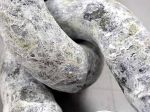Corrosion also known as degradation of material is the disintegration of a material at its micro constituent level due to chemical reactions with its surroundings environment.  The most common example of corrosion is rusting of iron. There are several modes and forms of corrosion and its mechanism. Corrosion resistance is the ability of a material to withstand particular type of environment without disintegration or degradation. Corrosion resistance can be improved by addition of alloying elements (stainless steels) , by application of protective coatings (galvanising) or connecting less noble material (anodising or cathodic protection) to the component to be protected.
The most common example of corrosion is rusting of iron. There are several modes and forms of corrosion and its mechanism. Corrosion resistance is the ability of a material to withstand particular type of environment without disintegration or degradation. Corrosion resistance can be improved by addition of alloying elements (stainless steels) , by application of protective coatings (galvanising) or connecting less noble material (anodising or cathodic protection) to the component to be protected.
see Corosion Resistance Test
LMATS performs regularly corrosion resistance tests in accordance with ASTM G48, ASTM G28, ASTM A923, ASTM A262, AS 2038, AS 2331.3.1, AS 2345, ASTM B117, ASTM A380, NACE, EXXON Mobil and ESSO Shell specification. Some of the commonly used industrial terminologies for these tests are:
- Pitting corrosion test
- Crevice corrosion test
- Intergranular corrosion test
- G48 test
- Copper Sulphate test
- Ferric Chloride test
- Nitric acid boiling test
- Neutral Salt Spray test
- Dezincification test
- Ferroxyl test
- High humidity test
- Resistance to Hydrogen Sulphide H2S cracking such as Sulphide stress cracking SSC
- Stress oriented Hydrogen Induced Cracking SOHIC
- Hydrogen Induced Cracking HIC
- Step Wise Cracking SWC
- Soft Zone Cracking SZC etc.
LMATS is approved by BAE UK to perform Titanium Intergranular Corrosion testing by measuring Intergranular attack (IGA) and end grain pitting.


